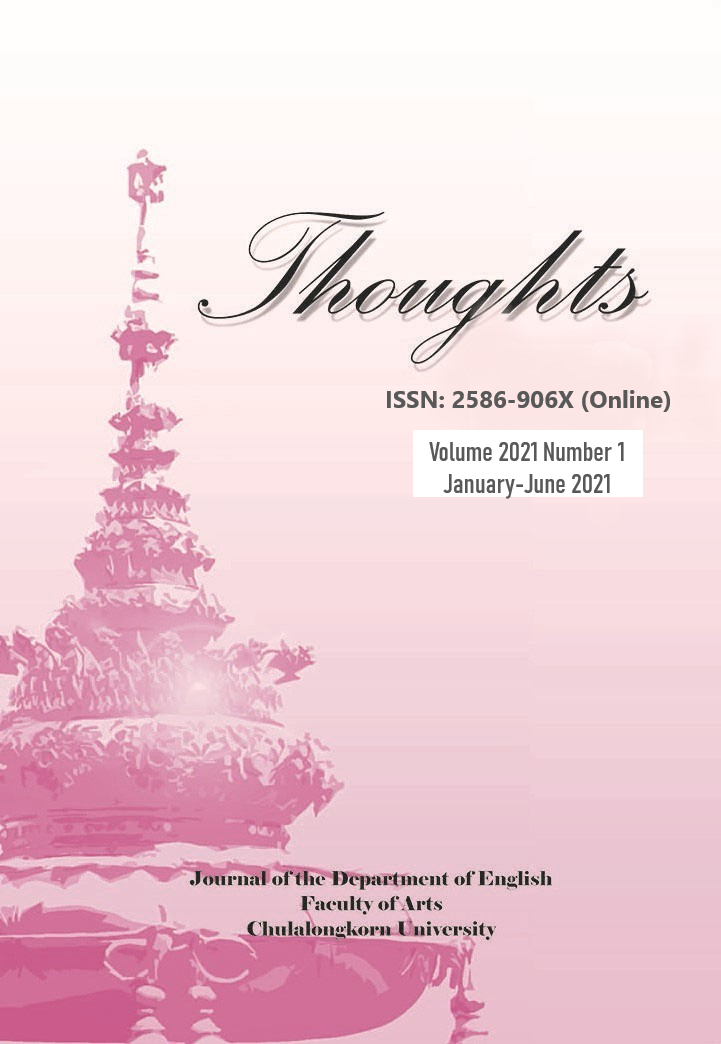Representation of the Body in Edward Bulwer-Lytton's The Coming Race
DOI:
https://doi.org/10.58837/CHULA.THTS.2021.1.2Keywords:
body, Victorian science fiction, Posthumanism, Edward Bulwer-Lytton, The Coming RaceAbstract
Many critics have suggested that most of the monstrous characters in late-Victorian British science-fiction novels represent social misfits and the cultural fear of physical and moral degeneration. However, scholars of critical posthumanism believed that the body born in a techno-scientific context can depict a progressive hybrid that destabilises the natural-unnatural dualism from an anthropocentric view. In line with this posthuman perspective, this article studies Edward Bulwer-Lytton’s The Coming Race (1871) in which the non-human characters, the Vril-ya, can be considered advanced beings instead of malformed monsters. It argues that such characters represent progression rather than degeneration since the portrayal of their electric body, a body integrated with electrical technology, affirms the necessity for a bio-technological reform of civilisation. Through the electric body, Bulwer-Lytton seems to suggest the possibility of a new form of life that co-evolves with technology.
References
Aspinall, A. & Smith, E. A. (Eds.). (1959). English Historical Documents, XI, 1783-1832. Oxford University Press.
Beveridge, A. W., & Renvoize, E. B. (1988). Electricity: A history of its use in the treatment of mental illness in Britain during the second half of the 19th century. The British Journal of Psychiatry, 153(2), 157-162. https://doi.org/10.1192/bjp.153.2.157
Braidotti, R. (2013). The Posthuman. Polity Press.
Bulwer-Lytton, E. (1871). The coming race. William Blackwood & Sons.
Bulwer-Lytton, V. (1913). The life of Edward Bulwer-Lytton: First Lord Lytton (Vol. 2). Macmillan.
Carlyle, T. (1852). Signs of the Time. The Modern British Essayists (Vol. 5), 187-196.
Chesterton, G. K. (1913). The Victorian Age in Literature. Williams & Norgate.
Emsley, C. (2011, February 17). Crime and the Victorians. BBC.
Greenslade, W. (1992). Fitness and the Fin de Siècle. In J. Stokes (Ed.), Fin de Siècle/Fin du Globe: Fears and Fantasies of the Late Nineteenth Century (pp. 37-51). Palgrave Macmillan UK. doi:2833/10.1007/978-1-349-22421-0_3
Haraway, D. (1985). A Manifesto for Cyborgs: Science, Technology and Socialist Feminism in the 1980s. Socialist Review, (80), 65-108.
Harkup, K. (2018, April). The science behind the fiction: Frankenstein in historical context. Nature History, 34-39.
http://frankenstein.honors.lmu.build/wp-content/uploads/2018/04/The-Science-Behind-Fiction.pdf
Hassler, D. (2009). Viagra for SF. Science Fiction Studies, 36(2), 355-356. http://www.jstor.org/stable/40649968
Hayles, N. K. (1999). How we became posthuman: Virtual bodies in cybernetics, literature, and informatics. University of Chicago Press.
Haynes, R. D. (1980). Science and Technology. In H. G. Wells: Discoverer of the future: The influence of science on his thought (pp. 69-81). Palgrave Macmillan.
Hurley, K. (1995). Reading like an alien: Posthuman identity in Ridley Scott’s Alien and David Cronenberg’s Rabid. In J. Halberstam & I. Livingston (Eds.), Posthuman Bodies (pp. 203-222). Indiana University Press.
Hurley, K. (1996). The Gothic body: Sexuality, materialism, and degeneration at the Fin de Siècle. Cambridge University Press.
Margree, V., & Randall, B. (2012). Fin-de-siècle Gothic. In A. Smith & W. Hughs (Eds.), The Victorian Gothic: An Edinburgh companion (pp. 217-233). Edinburgh University Press.
Milburn, C. N. (2003). Monsters in Eden: Darwin and Derrida. MLN 118(3), 603-621. http://www.jstor.com/stable/3251937
Morus, I. R. (1999). The measure of man: Technologizing the Victorian body. History of Science 37(3), 249-282. https://doi.org/10.1177/007327539903700301
Ng, A. H. (2004). Monstrous body. In Dimensions of monstrosity in contemporary narratives (pp. 144-174). Palgrave Macmillan. https://doi.org/10.1057/9780230502987_5
Parrinder, P. (2015). Strains of the non-human: The coming race, Erewhon, a crystal age. Utopian Literature and Science, 82-96.
Rossini, M. (2017). Bodies. In B. Clarke & M. Rossini (Eds.), The Cambridge companion to literature and the Posthuman (pp. 153-169). Cambridge University Press. https://doi.org/10.1017/9781316091227.015
Ruskin, J. (1867). The Stones of Venice: Volume the second. Smith, Elder & Co.
Shelley, M. W. (2004). Frankenstein; or, The modern prometheus. Simon & Schuster.
Szabo, L., & Crisan, M. (2018). Technological modification of the human body in Neo-Gothic literature: Prostheses, hybridization and
cyborgization in posthumanism. Caietele Echinox 35, 147-158. doi:10.24193/cechinox.2018.35.09
Downloads
Published
Issue
Section
License
Copyright (c) 2021 Thoughts

This work is licensed under a Creative Commons Attribution-NonCommercial-NoDerivatives 4.0 International License.
Copyright by the Faculty of Arts, Chulalongkorn University.
Photocopying is allowed for internal, non-commercial use only. Photocopying for other uses or for purposes other than indicated must be permitted in writing from the Faculty of Arts, Chulalongkorn University.
All views or conclusion are those of the authors of the articles and not necessarily those of the publisher or the editorial staff.


